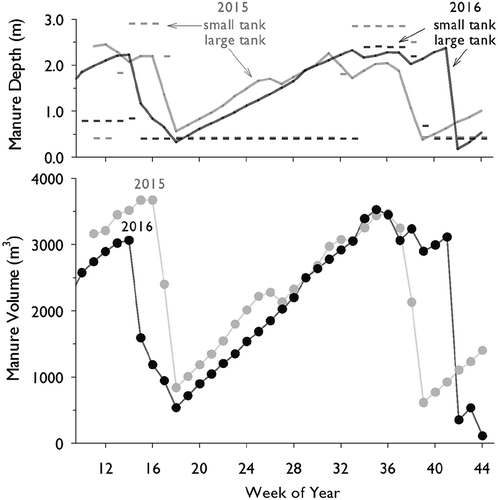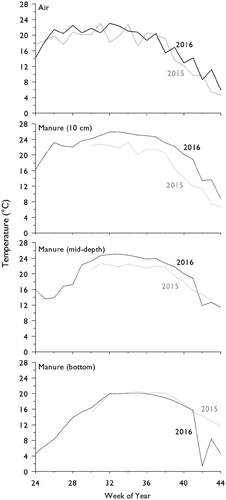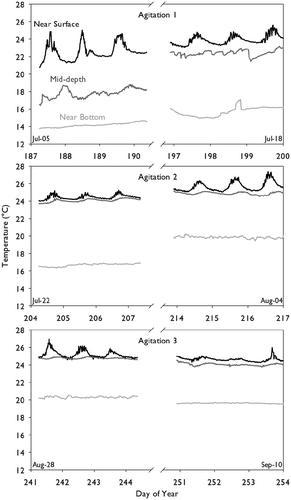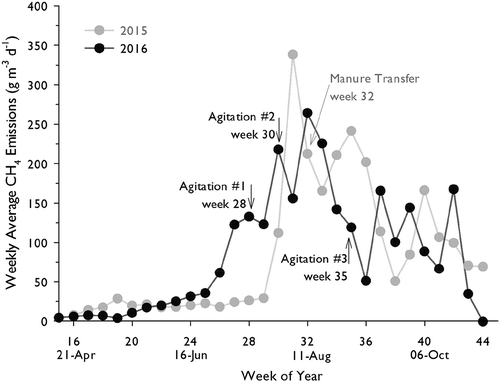Figures & data
Table 1. Manure characteristics: Dry Matter (DM), Volatile Solids (VS), Organic Carbon (OC), pH, Electrical Conductivity (EC), Nitrogen (N), Ammonia (NH3), Phosphorus (P), Potassium (K), total Volatile Fatty Acids (VFA), and Acetic Acid (AA) before, during, and after each agitation event (AG1-AG3), and on average.
Figure 1. Weekly average quantity of manure in storage during 2015 and 2016. Top panel: depth (m) in the small tank (314 m2; dashed lines) and large tank (1257 m2; solid lines). Bottom panel: total volume (m3) of stored manure in both tanks combined.

Table 2. Weekly average depth in the large tank (m), air temperature (°C, Ta), and stratified manure temperatures (°C, Tm) for weeks 30–38 in 2015 and 2016.
Figure 2. Weekly time series (weeks 24–44) of: air temperature (°C, top panel), manure temperature at 10 cm depth (°C, 2nd panel), manure temperature at mid-depth (°C, 3rd panel), and manure temperature at the bottom of the large storage tank (°C, bottom panel).

Figure 3. Stratified (top, middle, bottom) manure temperature (Tm, °C) profile of the large storage tank before and after agitation events. Top panel: Agitation 1 (AG1), DOY 196; middle panel: Agitation 2 (AG2), DOY 208; bottom panel: Agitation 3 (AG3), DOY 245. Each panel shows approximately 3d of data before and after each agitation event. Note: Gap between pre- and post- agitation data segments is not to scale.

Table 3. Summary of qPCR (gene copies and transcript copies) targeting Bacterial 16S rRNA (first), Archaeal 16S rRNA (second), and mcrA (third) from samples taken before, during and after three agitation events (AG1, AG2, AG3).
Table 4. Summary of methane (CH4) emission for 2014, 2015, and 2016 during the main period of methane emissions, which occur between spring and fall manure removal.
Figure 5. Daily time-lapse series showing surface foam formation of the large storage tank the day before first agitation event [AG1 (−1d)], during the first 5 hours of agitation (AG1 0h and 5h), the day after agitation [(AG1 (+1d)], until 5 days after agitation [AG1 (+5)]. Except during agitation, pictures were captured between 06:30 a.m. and 07:00 a.m. (before foam dissipated in the late morning).
![Figure 5. Daily time-lapse series showing surface foam formation of the large storage tank the day before first agitation event [AG1 (−1d)], during the first 5 hours of agitation (AG1 0h and 5h), the day after agitation [(AG1 (+1d)], until 5 days after agitation [AG1 (+5)]. Except during agitation, pictures were captured between 06:30 a.m. and 07:00 a.m. (before foam dissipated in the late morning).](/cms/asset/f92bd6c6-49c3-4e94-b0be-d8bc816a6eb7/uawm_a_1629359_f0005_oc.jpg)

